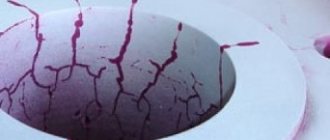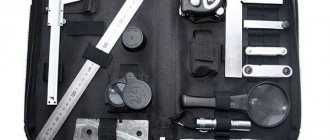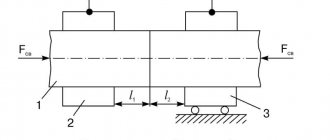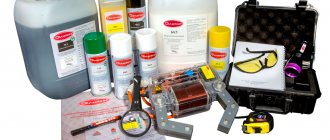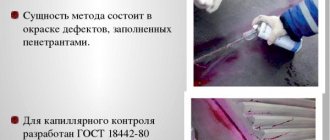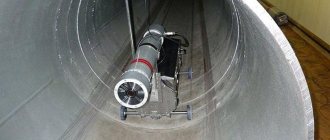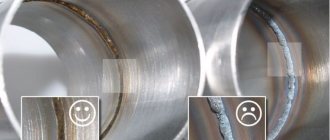After installing pipelines and technical tanks, it is important to check the tightness of the connection so that there is no leakage of transported media and the structure does not collapse under pressure. Structural welding defects and microcracks in the heat-affected zone are detected by capillary inspection of welds. To conduct research, contrast liquids that easily penetrate microdefects are used. Lack of penetration, fistulas, burns on the surface of the seam are immediately visible. Internal discontinuities of metals and non-metals (nylon, PVC, polyethylene) are determined using equipment for non-destructive diagnostics of welded joints. Inspection using dyes helps to detect defects and accurately determine the size of structural defects. Thanks to non-destructive color testing, it is possible to detect critical structural changes in and around the welded joint, in the heat-affected zone. If the welding technology is violated or overheated, residual stresses are formed at the seam, leading to the formation of cracks.
Operating principle of the capillary flaw detection method
In various industries and construction, NDT methods are used to detect surface and through microscopic defects in materials and structures, which are impossible to find without special optical instruments.
To search for this type of damage, penetrant flaw detection is used. This non-destructive method is based on the capillary effect.
Its essence lies in the capillary filling of cracks, scratches and pores with penetrants - special liquid colored substances. The developer then applied to the surface of the test object dissolves the dyes and, thanks to diffusion, clears the defective areas of them. As a result, due to the contrast between a single-color plane and colored damage, they become available for quantitative and qualitative assessment using visual inspection. On the surface of the test object, cracks and pores even a few microns in size appear as lines and dots. Penetrant flaw detection is also used in NDT of welds to detect lack of penetration, cavities, fistulas, as well as their localization, determination of size and orientation.
Job
The sequence of actions for capillary control is very simple. Now we will tell you everything in more detail, and you can see for yourself how easy this verification method is.
The first step is to clean the joint surface. You can use a solvent for this. It is necessary to remove all dirt, paint and oil residues from the outside of the seam.
Advantages and disadvantages of the capillary flaw detection method
Penetrant flaw detection has both positive aspects and disadvantages. Its advantages include:
- a simple technique for carrying out the non-destructive testing process;
- applicability of the capillary method to various materials, including non-magnetic metals;
- the ability to localize defective zones, determine their size, configuration and orientation, which makes it possible to determine the technical reasons for the formation of defects to prevent their occurrence in the future.
The negative aspects of the capillary method include the following:
- impossibility of detecting damage that does not extend to the surface of the test object;
- low probability of detecting surface and through defects, the opening of which exceeds 500 microns;
- the high labor intensity of the capillary method, since each study lasts from 0.5 to 1.5 hours;
- impossibility of automation of control;
- the influence of ambient temperature on the reliability of the capillary method;
- significant dependence of the results of the capillary method on the human factor;
- the influence of storage conditions and duration on the quality of flaw detection chemicals and the dependence of technical results on the quality of flaw detection chemicals.
Despite some negative aspects, penetrant flaw detection remains an effective non-destructive method for searching for surface and through defects.
How to apply liquid
We have already said that liquid application during capillary control can occur using a spray can or brush. These methods are the simplest. When working with a spray can and a brush, the substance itself penetrates into the seams.
You can also use one familiar method: immersing the part in a tank with a substance. The temperature regime of penetrates is from five to fifty degrees. Therefore, application can be done outdoors.
Another method of applying penetrant is called vacuum. It is much more expensive, but at the same time more effective. The workpiece is placed in a vacuum chamber, and then the air is pumped out. In areas with defects, the pressure level decreases.
Then a substance is launched that selects the places you need. This method is used when high-quality testing for defects is necessary, but another method cannot be used.
The latter method involves the use of sound and ultrasonic waves. They act on the liquid and drive it into the joints. However, when using this method, the defect may become deformed.
Technology of capillary flaw detection method
To obtain a real picture of the location, quantity and size of damage on the surface of the test object, detected by penetrant flaw detection, the following are sequentially performed:
- Cleaning, during which oil and grease stains, metallization and other coatings are removed from the surface of the test object. The surface, previously treated with solvent or water, is dried so that the defects are empty and dry;
- Treatment with a dye applied with a brush, spray or by immersing the product for a period of 5 to 30 minutes in a dye bath at a temperature of 5°C - 50°C, which allows for complete coverage of the test object. At this moment, due to the capillary effect, the dye fills the defect cavities;
- Preparing to apply developer. At this stage, the surface is cleaned of excess dye by cleaning the surface of the test object with a soft swab moistened with water or solvent. In this case, the penetrant is removed from the surface, but it should remain in the defect cavity. After processing, the working plane is dried;
- Formation of the developer layer. A layer of developer is formed on the object immediately after drying the control surface. It dissolves the dye filling the defective cavity and, thanks to diffusion, lifts the colored solution to the surface, visually marking the location of the damage. If the operations of the capillary flaw detection method are performed correctly, the value of the color mark turns out to be significantly larger than the real value of the surface defect. To identify through cracks during NDT of thin-walled products, good results are achieved by using penetrant and developer applied on opposite sides. The coloring matter, which has passed through the walls of the product due to the capillary effect, contrasts with the background on its other side;
- Control. On the dried developer, surface defects are highlighted by colored marks on a white background - lines or a cluster of dots. In this case, a more saturated color indicates a greater depth of the defect. Cracks, lack of fusion, and folds found in welds also appear as colored lines. If luminescent compounds were used during penetrant testing, the results are examined in a dark room using ultraviolet instruments. Defects appear as yellow-green luminous lines and dots.
The technical results of penetrant testing of an object are subject to visual assessment and can be recorded on photo, video media or transferred to adhesive tape.
Basic data
For capillary testing of connections, special liquids are used, and the entire method is based on this. These liquids have other names.
For example, indicators or penetrants. They have their own characteristics that you should know. One of these features is that it penetrates into the smallest defects and leaves a bright trace behind.
This mark can be seen without any equipment, so the worker can easily calculate the location of the defects. If the size of the defect is small, sometimes a magnifying loupe is used.
As you can see, there is nothing complicated in using the capillary method.
Using the capillary method you can find many different defects, not just cracks, but also burns and uncooked areas.
All flaws can be recognized without purchasing expensive devices. You will also be able to calculate the size of the defects and where they are located exactly throughout the connection.
At the same time, you can control different types of workpieces. For example, metal, glass or ceramic parts, as well as blanks made of artificial polymer.
Therefore, with such control you can work in several industries and this is a good quality for production.
Evaluation of the effectiveness of control using the capillary method
The effectiveness of testing by the capillary method is the assessment of the sizes of surface and through defects identified based on the results of observation and registration of traces left by indicators. The result is assessed in accordance with the sensitivity class of the capillary method - the ability to detect and record surface defects with a certain degree of probability through the use of a non-destructive method, a regulated technique and a certain penetrant. GOST 18442-80 regulates the interdependence of the control sensitivity class and the minimum value of surface defects detected during capillary NDT:
- the minimum opening width of the defect is less than 1 micron - corresponds to class I control sensitivity;
- width from 1 to 10 microns – II class of control sensitivity;
- 10 – 100 microns – III class;
- 100 – 500 microns – class IV;
- more than 500 microns – control sensitivity is not standardized.
Technical requirements for the characteristics of object control, as well as the necessary quality indicators, are presented by the developer of the product or semi-finished product.
Methods used
There are two groups of methods for carrying out capillary control: basic and combined.
Basic
The main methods involve the use exclusively of penetrant testing with liquid indicators.
Basic control methods:
- By types of solutions used:
- penetrating solutions;
- filter suspensions.
- By method of obtaining the result:
- brightness;
- luminescent;
- fluorescent color;
- color.
Combined
Combined methods involve the use of a number of non-destructive testing methods, one of which is capillary.
Combined methods:
- magnetic;
- electrostatic;
- radiation mode of emission or absorption;
- electroinduction.
The listed methods differ depending on their technology of exposure to the surface that can be tested.
Flaw detection materials
The degree of reliability of the visual assessment of the results of penetrant testing depends on the quality of the target sets of flaw detection materials that meet the conditions that apply to the test object. The target kit contains the following chemicals:
- penetrant;
- cleaner;
- developer.
Chemicals from sets or combinations must be mutually compatible and must not reduce the technical quality of controlled environments, semi-finished products or products.
One of the leaders in the domestic flaw detection market, from Kazan, offers sets and combinations of chemicals necessary when using the capillary method:
- Magnaflux SPOTCHECK SCD-S2 developer is used at temperatures from -5°C to +50°C, compatible with Magnaflux SPOTCHECK SKL-SP2 dark red penetrant and SKC-S cleaner;
- Sherwin D-106 developer suitable for use at temperatures down to -30°C in conjunction with Sherwin N-120 cleaner and Sherwin LTP-82 low-temperature penetrant;
- developer for color flaw detection Helling NORD TEST U-89 providing indication of defects up to 0.00025 mm in size, applicable at temperatures from -10°C to +100°C, compatible with dark red penetrant Helling NORD TEST U-88;
- Sherwin D-100 developer, compatible with Sherwin DP-55 universal dark red penetrant, Sherwin DR-60 cleaner in the operating temperature range from +10°C to +50°C.
| Developer Sherwin D-100 | Developer U-89 | Cleaner Magnaflux SKC-S |
These sets and combinations of chemicals make it possible to detect surface defects of any size and configuration; they cover the entire range of controlled environments, products and semi-finished products in all sensitivity classes.
The quality of flaw detection chemicals, as well as the correctness of the penetrant testing technique, is checked with a standard sample - a standard. The sample is a standard; it is a plate made of St20 steel with a dead-end crack made on its surface, the opening width of which corresponds to the I, II or III sensitivity class of capillary testing.
Kinds
Working with capillary control can go in two ways. The first is called the main one and consists in the fact that when working you use only one method.
The second way is called combined; as you might guess, it uses several types of defect checking. When working with capillary, you also use the radiographic method.
These two types also have their own branches. When using the first, you may be faced with a choice: work with a special solution or choose a method that requires a filter suspension.
And there are four more ways to identify the results of the check. Your choice may fall towards the chromatic or achromatic method, or maybe you will choose the luminescent or luminescent-chromatic method.
And this is all just about the first type of capillary control.
The combined method includes the presence of capillary control, and in conjunction with it, many other types of testing can be used. For example, the use of magnetic, induction, radiographic and other methods.
With any of these methods it is necessary to work with chemical liquids.
And in order to detect the results, for each individual method you need to use equipment that is suitable for the type of control being used. For radiographic inspection, X-ray equipment is used.
With such an inspection, you need to carry out a penetrant test, and then pass the part through an X-ray machine and take a picture to find the location of all defects.
What is a capillary?
The concept of the meaning of the word capillary can be explained as a crack that comes to the surface from only one side of the tested object. This action is called surface discontinuity. And the opposite walls, which help connect the object being used, are called through. Then you need to determine whether such values are defects. If suspicions are confirmed, then this system is called a surface or through defect. And the image that is obtained at the location of the break in the continuous connection is called an indicator pattern. There are also such concepts as depth and width of discontinuity. Depth implies the presence of the size of the gap in the products inside the object under study. And width is the concept of the longitudinal size of the discontinuities of the controlled product. There is also the meaning of opening, which implies transverse dimensional results located on the surface of the materials. The most important condition for penetrant testing is the presence of the action of reaching the surface of the controlled object. It is also necessary to fully control the contamination, depth and width of their opening. To perform controlled work better, it is necessary to apply a substance such as penetrant , which is used to clean surfaces.
How to Apply Developer
Now you know how to apply the penetrant agent and clean the part. It remains to understand in more detail the very last stage - applying the developer.
This stage is the most important, as it has a great influence on the control results. How you apply the developer is not very important. The important point here is choosing the right substance.
There are several types of developers. And each is designed for individual situations. For example, a dry developer is used in combination with a fluorescent penetrant. This type is quite expensive.
It is not used very often. However, the test results are very good.
There are also liquid substances for manifestation. They are made on various bases. The most popular ones use an aqueous suspension as a basis.
For application, you can use either spray cans or completely immerse the part in a container with developer. When using a container, you should not immerse it for a long time. After this, you need to dry the part again using a special hair dryer.
Another type of liquid developer is used on substances that are similar to solvents in their properties. Low price and high efficiency. For application use sprayers.
It takes ten to twenty minutes to develop. If you do not achieve the result you need, increase this time by another ten minutes.
Final part
With the capillary control method, you will not encounter any insurmountable difficulties and will not spend a lot of money.
Due to its accessibility, this method is used in many enterprises. You can meet familiar penetrant and developing substances both in the workshop of domestic workers and in large-scale production.
Compared to other inspection methods, some poor-quality areas can be missed using the capillary inspection method. But, if you cannot use special equipment, this choice will be the most reliable.
If you work from home and don't have a huge budget, this is also a good opportunity to check your work for defects.
Have you ever encountered penetrant testing of welded joints? Share your experience, it will be useful for beginners. Productivity at work!
